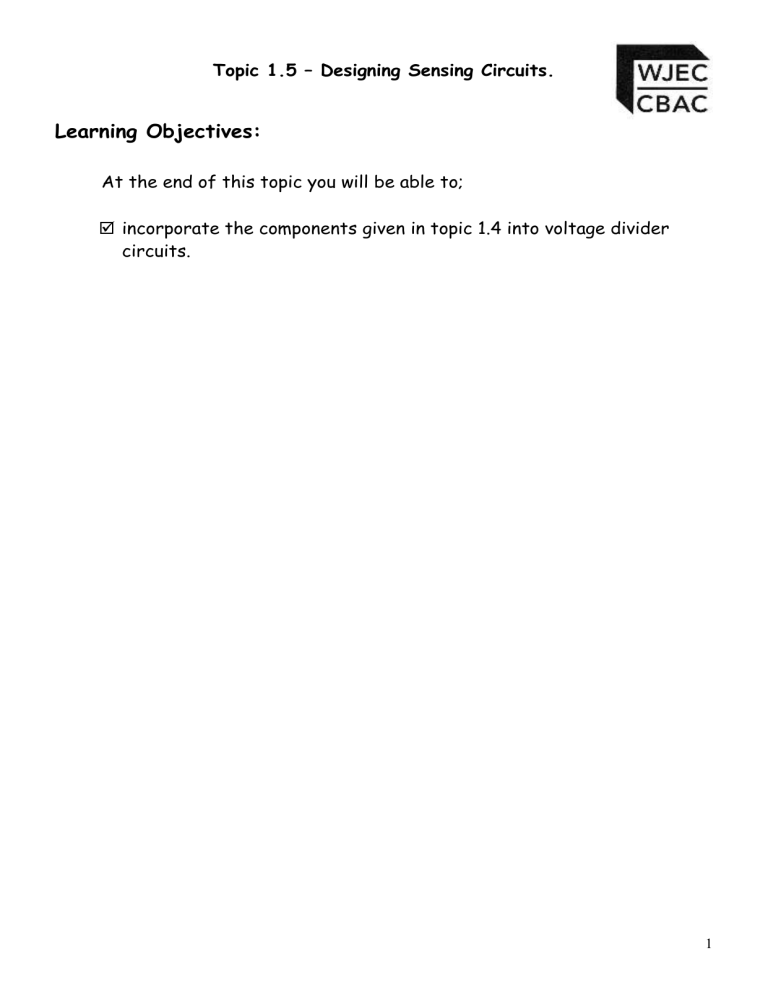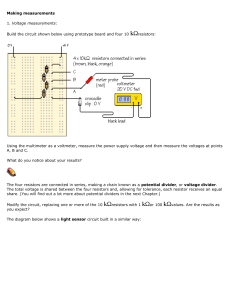Designing Sensing Circuits

Topic 1.5 – Designing Sensing Circuits.
Learning Objectives:
At the end of this topic you will be able to;
incorporate the components given in topic 1.4 into voltage divider circuits.
1
GCSE Electronics.
Unit E1 : Discovering Electronics
Designing Sensing Circuits
In the previous topic we looked at the characteristics of a Light Dependent
Resistor (LDR) and a thermistor. The resistance of both of these components change when the amount of light or temperature changes respectively.
This produces a very useful output when these components are connected into a voltage divider circuit.
The following circuits show what happens as the amount of light falling on an
LDR increases.
Here we can see that as the light level increases (more lux) the voltage at the output falls. We have created an analogue sensor where the output voltage decreases as the light level increases. Changing the position of the LDR and fixed resistor will give the opposite effect as shown below.
Here we can see that the output voltage increases as the light level increases.
2
Topic 1.5 – Designing Sensing Circuits.
Sometimes it is necessary to be able to adjust the output voltage to be a specific value at a particular light intensity. Whilst we could just experiment with a number of fixed resistors until we obtained the value we wanted, it is much quicker and easier to either include a variable resistor in series with the fixed resistor, or to just use a variable resistor on its own.
The following circuit diagrams show the effect of adding a series variable resistor with the fixed resistor.
Careful examination of the output voltage shows that small differences to the output voltage range can be made depending on the setting of the variable resistor.
3
GCSE Electronics.
Unit E1 : Discovering Electronics
The following circuits show the effect when only a variable resistor is used with the LDR.
Again we have set up a range of output voltages that can be adjusted by the setting of the variable resistor. You should investigate these circuits in your circuit simulator and check for yourself that they are fully adjustable.
We have now created a sensor that outputs a voltage which is dependent on the amount of light falling on a resistor. A change in resistance has therefore been changed into a change of voltage.
4
Topic 1.5 – Designing Sensing Circuits.
A problem!
Consider the circuits below:
In the left hand circuit the light level has been set so that the output voltage is very nearly 6V. The circuit on the right has a light bulb connected across the LDR. The light bulb does not light. The voltage has dropped to just
22.42mV.
If you think back to our work on systems, you might be able to remember the reason why this circuit does not work. The block diagram for a system was as follows:
Input
Input Signal Output
Output
Signal
Sensor Processing Device
Signal
In the circuit on the right above we only have the Input Sensor and the
Output Device, there is no processing section which in this case would simply be a driver circuit.
We have now built the sensor circuit (to give either a falling or rising voltage) but before it can be used in a circuit we need to understand how to make a driver circuit to go with it – we will cover these circuits in Topic 1.7 –
Switching Circuits.
5
GCSE Electronics.
Unit E1 : Discovering Electronics
In a similar way, the thermistor can also be used in voltage divider circuits to provided a change in voltage which is dependent on the temperature of the thermistor.
The following circuits show the thermistor connected in series with a variable resistor, such that the voltage at the output falls when the temperature rises.
As was the case with the LDR, swapping the position of the thermistor and variable resistor will give the opposite effect, of a rising voltage at the output as temperature rises. This is illustrated below.
This circuit also requires a driver circuit before it can be used with any real effect in a circuit, however you may be asked to work out the output voltage at specific conditions, where the resistance values are known. A couple of worked examples are shown on the following pages to show you how these are done.
6
Topic 1.5 – Designing Sensing Circuits.
Worked Examples
1. A thermistor is connected in a voltage divider with a 10kΩ fixed resistor as shown below.
At 30°C the thermistor has a resistance of 20kΩ. At 100°C the resistance of the thermistor has fallen to 2.5kΩ.
(a) Determine the output voltage from the sensor at 30°C.
Apply the voltage divider formula to the sensing circuit, with
R1=20k.
V out
V
S
R 2
R 1
R 2
6
10
10
60
2 V
20 30
(b) Determine the output voltage from the sensor at 30°C.
Apply the voltage divider formula to the sensing circuit, with
R1=2.5k.
V out
6
V
S
2 .
5
10
R 2
R 1
R 2
10
60
12 .
5
4 .
8 V
7
GCSE Electronics.
Unit E1 : Discovering Electronics
2. An LDR is connected in a voltage divider with a 15kΩ fixed resistor as shown below.
At 300 lux the LDR has a resistance of 150kΩ. At 1000 lux the resistance of the LDR has fallen to 5kΩ.
Look carefully at the resistor labels, they are not conveniently the right way around to fit correctly in the formula, so it is often better to use the labels R
T
for the top resistor and R
B
for the bottom one.
(a) Determine the output voltage from the sensor at 300 lux.
Apply the voltage divider formula to the sensing circuit, with
R
2
[or R
B
] =150k.
V out
V
S
R
T
R
B
R
B
6
150
900
5 .
45 V
15 150 165
(b) Determine the output voltage from the sensor at 1000 lux.
Apply the voltage divider formula to the sensing circuit, with
R
2
[or R
B
] =5k.
V out
V
S
R
T
R
B
R
B
6
5
150
100
900
105
8 .
57 V
8
Topic 1.5 – Designing Sensing Circuits.
Homework Questions 1
1. A thermistor is connected in a voltage divider with a 4.7kΩ fixed resistor as shown below.
At 20°C the thermistor has a resistance of 18.4kΩ. At 80°C the resistance of the thermistor has fallen to 1.1kΩ.
(a) Determine the output voltage from the sensor at 20°C.
.............................................................................................................................
...................................................................................................................... [2]
(b) Determine the output voltage from the sensor at 80°C.
.............................................................................................................................
....................................................................................................................... [2]
2. An LDR is connected in a voltage divider with a 22kΩ fixed resistor as shown below.
9
GCSE Electronics.
Unit E1 : Discovering Electronics
At 200 lux the LDR has a resistance of 272kΩ. At 800 lux the resistance of the LDR has fallen to 3.9kΩ.
3.
(a) Determine the output voltage from the sensor at 200 lux.
.............................................................................................................................
...................................................................................................................... [2]
(b) Determine the output voltage from the sensor at 800 lux.
.............................................................................................................................
...................................................................................................................... [2]
Draw a circle around the correct answers
(a) What happens to the resistance of the thermistor as the temperature increases? stays the same increases decreases [1]
(b) What happens to value of V
OUT
as the temperature increases? stays the same increases decreases [1]
10
Topic 1.5 – Designing Sensing Circuits.
Solutions to Homework Question 1
1. (a) Apply the voltage divider formula to the sensing circuit, with
R
B
=18.4kΩ.
V out
V
S
R
T
18 .
4
R
B
R
B
7 .
17 V
9
4 .
7
18 .
4
165 .
6
23 .
1
(b) Apply the voltage divider formula to the sensing circuit, with
R
B
=1.1kΩ.
V out
V
S
1 .
1
R
T
R
B
R
B
2 .
06 V
9
4 .
7
1 .
1
9 .
9
5 .
8
2. (a) Apply the voltage divider formula to the sensing circuit, with
R
T
=272kΩ.
V out
V
S
R
T
R
B
R
B
0 .
90 V
12
22
272
22
264
294
(b) Apply the voltage divider formula to the sensing circuit, with
R
T
=3.9kΩ.
V out
12
V
S
R
T
R
B
R
B
10 .
19 V
3 .
9
22
22
264
25 .
9
3. (a) decreases
(b) decreases
No examination questions have been set in this topic as the design of sensing circuits will reappear in a later topic where it is more appropriate to test the design aspect of these circuits.
11
GCSE Electronics.
Unit E1 : Discovering Electronics
Summary
The two possible arrangements for an input sensor incorporated into a voltage divider circuit are
Either or
1.
For a light sensing circuit the sensor should be at the top
2.
For a darkness sensing circuit the sensor should be at the bottom
3.
For a decrease in temperature sensing circuit the sensor should be at the bottom
4.
For an increase in temperature sensing circuit sensor should be at the
top
Note: All of the above arrangements provide V
OUT
which increases from low to high.
12
Topic 1.5 – Designing Sensing Circuits.
Self Evaluation Review
Learning Objectives
My personal review of these objectives:
incorporate the components given in topic 1.4 into voltage divider circuits.
Targets: 1. ………………………………………………………………………………………………………………
………………………………………………………………………………………………………………
2.
………………………………………………………………………………………………………………
………………………………………………………………………………………………………………
13








